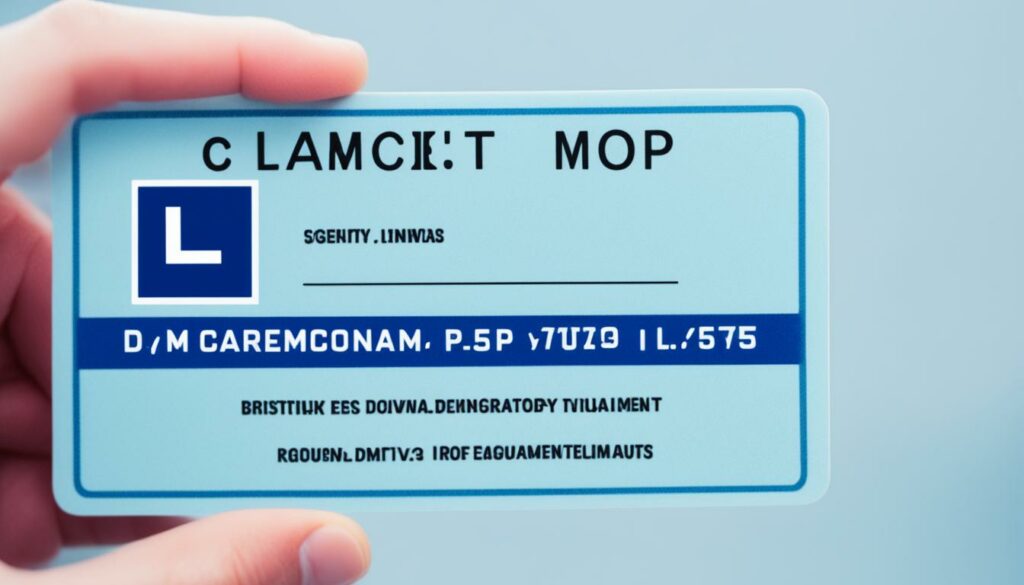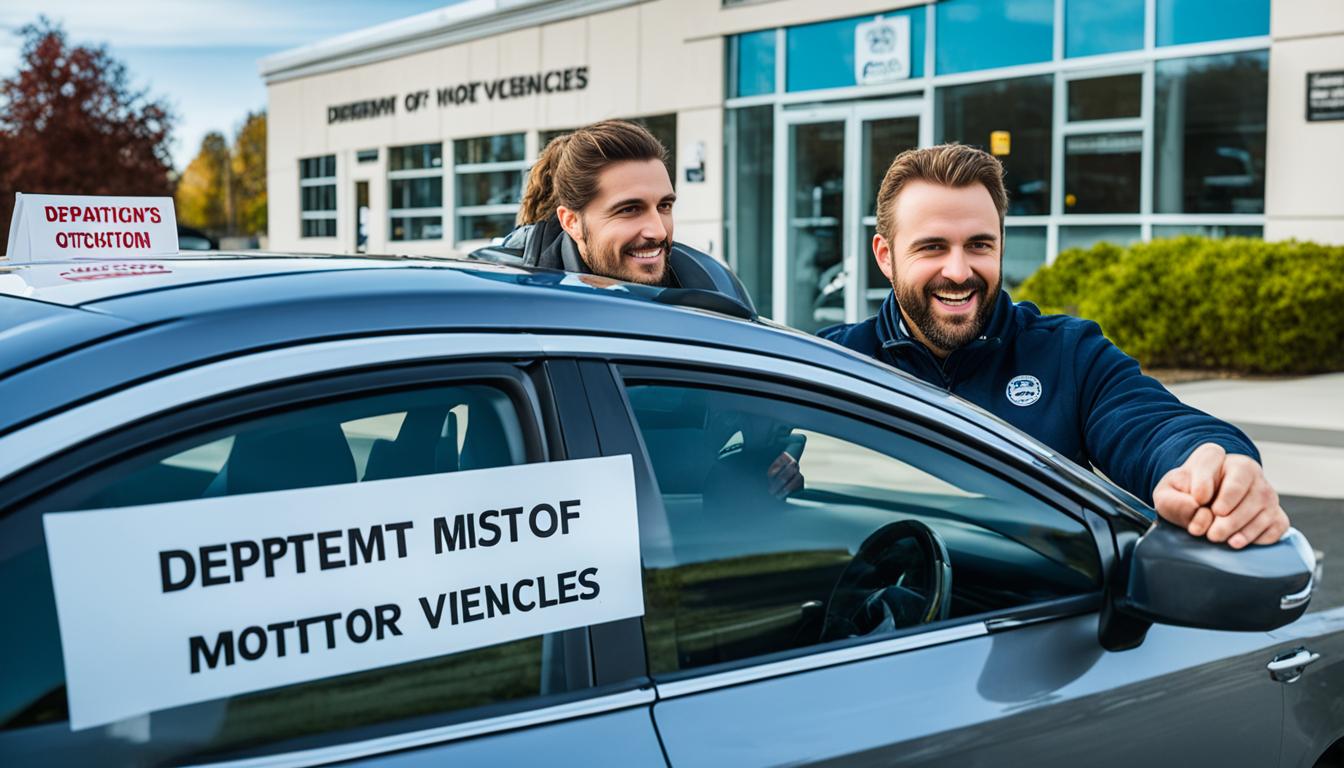Get Your Driver’s License at 18 – Simple Steps
Are you turning 18 and eager to obtain your driver’s license? Getting your driver’s license at 18 is an exciting milestone that unlocks newfound independence and opens up a world of possibilities. To ensure a smooth application process, it’s crucial to understand the requirements and steps involved. Whether you’re familiar with the driving test procedures or are new to the process, this guide will provide you with the essential information to help you navigate the path to obtaining your driver’s license at 18.
Key Takeaways:
- Getting your driver’s license at 18 requires following specific steps and meeting the legal driving age requirements.
- The process may vary by state, so it’s essential to research the driver’s license requirements in your state.
- The first step is obtaining a learner’s permit, which allows you to practice driving under the supervision of a licensed adult.
- Completing a driver’s education course can enhance your driving skills and increase your chances of passing the driving test.
- Practicing driving with a licensed adult and building your driving experience is crucial before taking the driving test.
Understanding the Legal Requirements

When it comes to obtaining your driver’s license at 18, it’s important to understand the legal requirements in your state. Each state has its own laws and regulations regarding the legal driving age and the specific requirements for obtaining a driver’s license.
These requirements can vary widely, so it’s crucial to research and familiarize yourself with the regulations in your state. Some common legal driving age requirements include:
- The minimum age to obtain a driver’s license
- Proof of identity and residency
- Completion of driver’s education courses
- Supervised driving hours
It’s worth noting that there may be additional requirements beyond these, depending on your state’s laws. To get accurate and up-to-date information on the legal driving age and driver’s license requirements in your state, it’s recommended to visit your state’s Department of Motor Vehicles (DMV) or their official website.
Below is a table summarizing the legal driving age and driver’s license requirements in a few select states:
| State | Legal Driving Age | Driver’s License Requirements |
|---|---|---|
| New York | 16 and above | Learner’s permit, supervised driving hours, driver’s education |
| California | 16 and above | Learner’s permit, supervised driving hours, driver’s education |
| Texas | 16 and above | Learner’s permit, supervised driving hours, driver’s education |
| Florida | 16 and above | Learner’s permit, supervised driving hours, written and driving tests |
Remember, this is just a sample of select states, and the requirements can change. Always consult your state’s DMV for the most accurate and up-to-date information.
Understanding the legal requirements in your state is crucial to ensure a smooth and successful application process for your driver’s license at 18. By familiarizing yourself with these requirements, you’ll be well-prepared to navigate the process and take the necessary steps toward obtaining your driver’s license.
Obtaining a Learner’s Permit

The first step in getting your driver’s license at 18 is obtaining a learner’s permit. This permit allows you to practice driving under the supervision of a licensed adult. To apply for a learner’s permit, you will need to visit your local DMV office, complete an application form, provide the necessary documentation (such as proof of identity and residency), and pass a written knowledge test. Once you have your learner’s permit, you can begin practicing driving with a licensed adult.
It’s important to take the process of obtaining a learner’s permit seriously. Familiarize yourself with your state’s specific requirements, as they may vary. The DMV website or a local DMV office can provide you with detailed information.
“Getting your learner’s permit is an important milestone on your journey to obtaining your driver’s license. It’s an opportunity to develop your driving skills under the guidance of a responsible adult. Remember to always follow traffic laws and practice safe driving habits.”
During this stage, it’s advisable to enroll in a driver’s education course to enhance your knowledge and skills. These courses typically cover essential topics such as traffic laws, defensive driving techniques, and proper signaling.
Once you feel confident in your understanding of the rules of the road, it’s time to put your knowledge into practice. Find a licensed adult who can accompany you during your practice sessions. Make sure to adhere to any requirements regarding the supervising adult’s age and qualifications.
Using your learner’s permit, take the opportunity to gain practical experience behind the wheel. Familiarize yourself with the basics of vehicle operation, parking, and navigating different road conditions. It’s essential to build your confidence and ensure you’re prepared for the challenges of the road.
| Learner’s Permit Requirements | Documents to Bring | Written Knowledge Test Pass Rate |
|---|---|---|
| Minimum age of 18 | – Proof of identity (e.g., birth certificate, passport) – Proof of residency (e.g., utility bill, rental agreement) – Social Security number (if applicable) |
80% |
Remember, the learner’s permit is just the first step towards obtaining your driver’s license at 18. Stay focused, practice regularly, and continue to study the rules of the road. The next section will guide you through the process of completing driver’s education.
Completing Driver’s Education

When it comes to obtaining your driver’s license at 18, completing driver’s education is an important step that shouldn’t be overlooked. While driver’s education is often required for those under 18, it can also be beneficial for anyone seeking their driver’s license at this age. By participating in a driver’s education course, you can gain valuable knowledge and develop the necessary skills for safe driving.
Driver’s education courses typically consist of both classroom instruction and behind-the-wheel training. In the classroom, you’ll learn essential information about traffic laws, rules of the road, defensive driving techniques, and more. This knowledge will not only help you pass the required exams but also provide a strong foundation for a lifetime of responsible driving.
Behind-the-wheel training is another crucial component of driver’s education. This hands-on experience allows you to practice driving skills under the guidance of a qualified instructor. You’ll have the opportunity to learn proper techniques for maneuvering, parking, and navigating various road conditions. This practical experience is invaluable in building your confidence as a driver and preparing you for the challenges of the road.
To find driver’s education courses in your area, check with your local Department of Motor Vehicles (DMV) for a list of approved providers. They can provide you with information on course availability, requirements, and fees. It’s important to choose a reputable and licensed driver’s education provider to ensure you receive quality instruction that meets your state’s requirements.
| Benefits of Completing Driver’s Education |
|---|
| 1. Gain comprehensive knowledge of traffic laws and regulations |
| 2. Develop safe driving habits and defensive driving skills |
| 3. Learn how to navigate various road and weather conditions |
| 4. Build confidence as a driver through hands-on practice |
| 5. Increase the likelihood of passing the driving test |
Remember, driver’s education is not just about getting your license; it’s about becoming a responsible and skilled driver. So take advantage of this opportunity to learn from experienced instructors and prepare yourself for a lifetime of safe and enjoyable driving.
Practicing Driving with a Licensed Adult

Now that you have your learner’s permit, it’s time to gain practical driving experience by practicing with a licensed adult. This adult should be a responsible and experienced driver who can provide guidance and instruction as you navigate the roads. Practicing driving with a licensed adult is essential to build your skills and confidence behind the wheel.
During your practice sessions, it’s important to follow all traffic laws and regulations. This not only ensures your safety but also helps you develop good driving habits from the start. Remember to obey speed limits, use turn signals, and always keep a safe distance from other vehicles.
Make the most of your practice sessions by driving in a variety of conditions. This includes practicing during different times of the day and in different weather conditions. By exposing yourself to various driving scenarios, you’ll become more comfortable and adaptable on the road.
It’s worth noting that many states have specific requirements for supervised driving hours. These requirements may vary, so it’s important to familiarize yourself with your state’s guidelines. Ensure that you meet the minimum number of supervised driving hours before scheduling your driving test.
| Benefits of Practicing with a Licensed Adult |
|---|
| 1. Guidance and instruction from an experienced driver |
| 2. Development of good driving habits |
| 3. Exposure to various driving conditions |
| 4. Building skills and confidence behind the wheel |
| 5. Meeting the requirements for supervised driving hours |
Remember, practice makes perfect! The more time you spend practicing with a licensed adult, the better prepared you’ll be for your driving test and ultimately obtaining your driver’s license at 18.
Taking the Driving Test
The final step in obtaining your driver’s license at 18 is to pass the driving test. This test consists of two parts: a written knowledge test and a practical driving test. The written knowledge test evaluates your understanding of traffic laws and driving regulations, while the practical driving test assesses your ability to safely operate a vehicle.
To increase your chances of success, it’s important to study and prepare for both tests. Start by reviewing your state’s driving manual, which contains essential information about traffic laws and safe driving practices. Use online practice tests or study guides to test your knowledge and familiarize yourself with the types of questions that may be asked in the written test.
For the practical driving test, practice your driving skills and become comfortable with various maneuvers such as parking, lane changes, and turning. Practice in different weather conditions and at different times of the day to gain confidence in various driving scenarios. Consider taking driving lessons with a professional instructor who can provide guidance and help you improve your skills.
When you feel ready, contact your local DMV to schedule your driving test. They will provide information on the specific test procedures and any additional requirements for your state. On the day of the test, arrive early, bring all necessary documentation, and ensure your vehicle is properly registered and in good working condition.
During the driving test, remain calm and focus on demonstrating your safe driving skills. Listen carefully to the examiner’s instructions and follow them accurately. Remember to use your mirrors, signal clearly, obey traffic signs and signals, and maintain a safe distance from other vehicles.
After completing both parts of the test, the examiner will provide you with the results. If you pass, congratulations! You will be issued your driver’s license. If you don’t pass, don’t be discouraged. Use the experience as an opportunity to identify areas for improvement and continue practicing. You can schedule a retest and work on refining your skills to achieve success in your next attempt.
Additional Requirements for International Drivers
If you are an international driver seeking to obtain a driver’s license at 18 in the United States, there may be additional requirements to consider. Some states may require international drivers to provide proof of legal presence in the country, such as a valid visa or passport. Additionally, international drivers may need to take additional steps, such as passing a written knowledge test or completing a driver’s education course. It’s important to check with your state’s DMV for specific requirements and guidelines.
International drivers who wish to obtain a driver’s license in the United States should be aware that each state has its own set of rules and regulations. It’s crucial to ensure compliance with these requirements to avoid any complications during the application process.
Proof of Legal Presence
Many states require international drivers to provide proof of legal presence in the country. This may include a valid visa, passport, or other documentation that verifies your status. The specific documents required may vary by state, so it’s essential to check with your state’s DMV for the exact requirements.
Written Knowledge Test
In some cases, international drivers may need to pass a written knowledge test to demonstrate their understanding of traffic laws and regulations in the United States. This test typically covers topics such as road signs, traffic signals, and driving rules specific to the state you are applying in. It’s important to study and prepare for the test to increase your chances of passing.
Driver’s Education Course
Certain states may require international drivers to complete a driver’s education course before obtaining a driver’s license. This course provides essential information and training on safe driving practices, traffic laws, and defensive driving techniques. Completing a driver’s education course can help international drivers familiarize themselves with the rules of the road in the United States.
It’s important to note that the specific requirements for international drivers may vary by state. Some states may have additional requirements or procedures in place. To ensure a smooth application process, it is highly recommended to contact your state’s DMV or visit their website for detailed information and guidelines.
| State | Proof of Legal Presence | Written Knowledge Test | Driver’s Education Course |
|---|---|---|---|
| California | Valid visa or passport | Yes | Yes |
| Texas | Valid visa or passport | No | Yes |
| New York | Valid visa or passport | Yes | No |
| Florida | Valid visa or passport | Yes | Yes |
Renewing or Replacing Your Driver’s License
Once you have obtained your driver’s license at 18, it’s important to keep it valid and up to date. Driver’s licenses typically expire after a certain period of time and will need to be renewed. The process for renewing a driver’s license may vary by state, but generally involves completing an application and paying a renewal fee. If your license is lost, stolen, or damaged, you will need to apply for a replacement. Contact your local DMV for specific instructions on renewing or replacing your driver’s license.
If you need to renew your driver’s license, the process is relatively straightforward. You will typically need to fill out an application form, provide any necessary documentation, such as proof of residency or identification, and pay the renewal fee. Some states may require a vision test as well. It’s important to note that renewing your driver’s license on time is essential to avoid driving with an expired license, which may result in penalties and legal consequences.
If your driver’s license is lost, stolen, or damaged, you will need to apply for a replacement. This process usually involves completing an application form, providing any necessary documentation, such as a police report for a stolen license, and paying a replacement fee. It’s important to report a lost or stolen license to the authorities to protect yourself from identity theft or fraudulent use.
Remember, the specific requirements and procedures for renewing or replacing your driver’s license may vary by state, so it’s important to contact your local DMV for accurate and up-to-date information. Keeping your driver’s license valid and in good condition ensures that you can continue to enjoy the privileges and freedom of driving safely and legally.
Knowing Your State’s Specific Requirements
When it comes to obtaining your driver’s license at 18, it’s crucial to understand the specific requirements set by your state. Each state has its own documentation requirements, age restrictions, and testing procedures that you need to be aware of. By familiarizing yourself with these requirements, you can navigate the application process smoothly and increase your chances of successfully getting your license at 18.
To ensure that you have accurate information, it is recommended to research your state’s Department of Motor Vehicles (DMV) website or visit a local DMV office. These resources will provide detailed information regarding the necessary documentation, age restrictions, and any additional tests or training you may need to complete.
Understanding your state’s specific requirements is essential because they may differ from other states. For example, some states might require specific forms of identification, proof of residency, or additional training courses. By knowing and fulfilling these requirements, you can be well-prepared and avoid any delays or complications during the application process.
Whether you are applying for your driver’s license in California, Texas, New York, or any other state, take the time to research and understand your state’s unique requirements. This knowledge will empower you to confidently pursue your driver’s license at 18, knowing that you have met all the necessary criteria.
Having a clear understanding of your state’s specific requirements for obtaining a driver’s license at 18 is crucial. By taking the time to research, gather the necessary documentation, and fulfill the criteria, you can successfully obtain your driver’s license and embrace the freedom and independence that comes with it.
Conclusion
Obtaining your driver’s license at 18 is an exciting milestone that opens up new opportunities for independence and mobility. By following the necessary steps, including obtaining a learner’s permit, completing driver’s education, practicing driving with a licensed adult, and passing the driving test, you can successfully obtain your driver’s license at 18.
It’s important to familiarize yourself with your state’s specific requirements and guidelines to ensure a smooth application process. Be sure to research the legal driving age, necessary documentation, and any additional requirements for driver’s education or supervised driving hours.
Remember, safety should always be your top priority. Once you have your driver’s license, drive responsibly and follow all traffic laws to protect yourself and others on the road. Congratulations on this achievement and enjoy the freedom that comes with getting your license at 18!
FAQ
What are the steps to get your driver’s license at 18?
To get your driver’s license at 18, you will need to follow a few simple steps. These steps may vary depending on your state, but generally involve obtaining a learner’s permit, completing driver’s education, practicing driving with a licensed adult, and passing a driving test.
What are the legal requirements for obtaining a driver’s license at 18?
Each state has its own laws regarding the legal driving age and requirements for obtaining a driver’s license at 18. It’s important to research and understand the specific requirements in your state, including any necessary documentation, age restrictions, and residency requirements.
How do I obtain a learner’s permit?
The first step in getting your driver’s license at 18 is obtaining a learner’s permit. To apply for a learner’s permit, you will need to visit your local DMV office, complete an application form, provide the necessary documentation, and pass a written knowledge test.
Is driver’s education required to get a driver’s license at 18?
Driver’s education is commonly required for those under 18, but it may also be beneficial for those seeking their driver’s license at 18. These courses typically include classroom instruction and behind-the-wheel training. Check with your local DMV to see if driver’s education is required in your state.
How should I practice driving with a licensed adult?
Once you have your learner’s permit, it’s important to gain practical driving experience with a licensed adult. This adult should be a responsible and experienced driver who can provide guidance and instruction while you practice driving. Be sure to follow all traffic laws and drive in a variety of conditions to build your skills and confidence behind the wheel.
What does the driving test include?
The driving test typically includes both a written knowledge test and a practical driving test. The knowledge test assesses your understanding of traffic laws and driving regulations, while the driving test evaluates your ability to safely operate a vehicle. It’s important to study and prepare for both tests to increase your chances of success.
Are there additional requirements for international drivers seeking a driver’s license at 18 in the United States?
Yes, there may be additional requirements for international drivers. Some states may require proof of legal presence in the country, such as a valid visa or passport. Additionally, international drivers may need to take additional steps, such as passing a written knowledge test or completing a driver’s education course. Check with your state’s DMV for specific requirements and guidelines.
How do I renew or replace my driver’s license?
Once you have obtained your driver’s license at 18, it’s important to keep it valid and up to date. Driver’s licenses typically expire after a certain period of time and will need to be renewed. The process for renewing a driver’s license may vary by state, but generally involves completing an application and paying a renewal fee. If your license is lost, stolen, or damaged, you will need to apply for a replacement. Contact your local DMV for specific instructions.
What are the state-specific requirements for obtaining a driver’s license at 18?
Each state may have different documentation requirements, age restrictions, and testing procedures. It’s important to research and familiarize yourself with your state’s specific requirements by visiting your state’s DMV website or a local DMV office for detailed information.
How can I get my driver’s license at 18?
By following the necessary steps, including obtaining a learner’s permit, completing driver’s education, practicing driving with a licensed adult, and passing the driving test, you can successfully obtain your driver’s license at 18. Familiarize yourself with your state’s specific requirements and guidelines to ensure a smooth application process.







